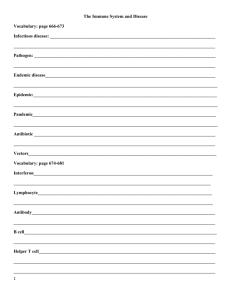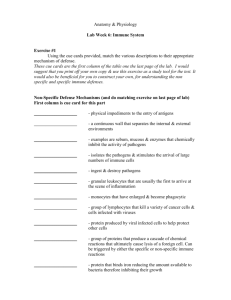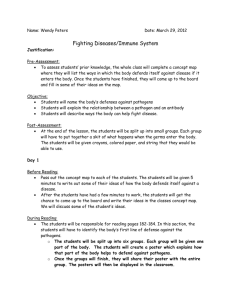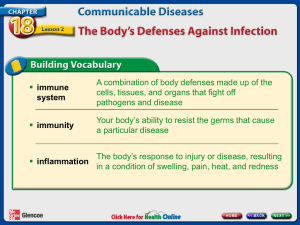C18_L2 - iatscience10
advertisement
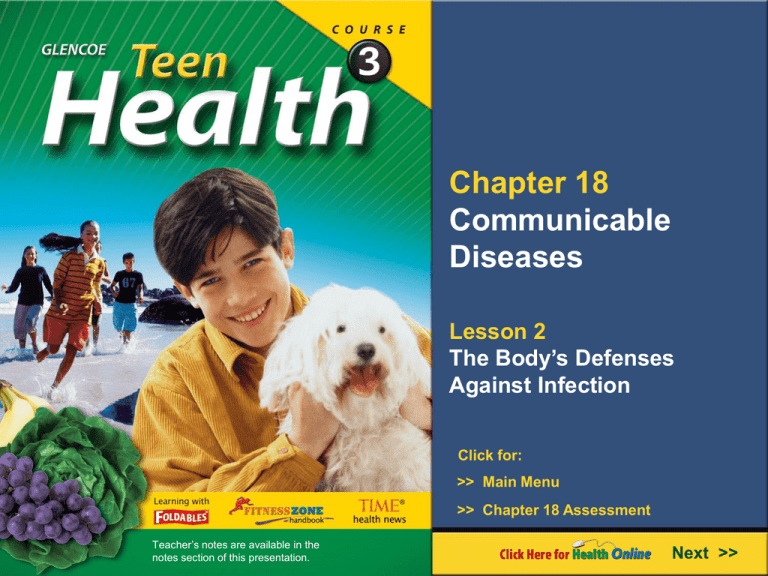
Chapter 18 Communicable Diseases Lesson 2 The Body’s Defenses Against Infection Click for: >> Main Menu >> Chapter 18 Assessment Teacher’s notes are available in the notes section of this presentation. Next >> immune system A combination of body defenses made up of the cells, tissues, and organs that fight off pathogens and disease immunity Your body’s ability to resist the germs that cause a particular disease inflammation The body’s response to injury or disease, resulting in a condition of swelling, pain, heat, and redness lymphatic system A secondary circulatory system that helps the body fight pathogens and maintain its fluid balance lymphocytes The white blood cells in the lymphatic system antigen Any substance released by invading pathogens antibodies Proteins that attach to antigens, keeping them from harming the body vaccine A preparation of dead or weakened pathogens that causes the immune system to produce antibodies In this lesson, you will learn to name the body’s first line of defense against pathogens. describe how the immune system functions. explain how antibodies protect the body. practice behaviors that keep your immune system healthy. Sequencing Draw a concept map that shows different ways your body works to defend itself from pathogens entering your body. Use Figure 18.2 as a guide. Body’s Defenses Your Body Defends Itself The Five Major Barriers Tears Saliva Mucous Membranes Skin Stomach Acid Your Body Defends Itself If a pathogen gets past one of the five major barriers, your body’s immune system takes over. immune system A combination of body defenses made up of the cells, tissues, and organs that fight off pathogens and disease Your Body Defends Itself Your immune system’s two main responses are the nonspecific response and the specific response. Together, these responses provide immunity. immunity Your body’s ability to resist germs that cause a particular disease Nonspecific Immune Response The nonspecific response begins with inflammation. inflammation The body’s response to injury or disease, resulting in a condition of swelling, pain, heat, and redness With inflammation, the body starts producing a protein called interferon to stimulate the body’s immune system. Specific Immune Response Each specific response is customized to attach a particular pathogen and its toxins. Our immune system can “recognize” pathogens it has already battled. The Lymphatic System The fluid circulation in the lymphatic system is called lymph (LIMF). lymphatic system A secondary circulatory system that helps the body fight pathogens and maintains its fluid balance The Lymphatic System The two types of lymphocytes are B cells and T cells. lymphocytes The white blood cells in the lymphatic system B cells form in the bone marrow. T cells develop in the thymus gland. The Lymphatic System Macrophages are found in the lymph. Their purpose is to attach themselves to invading pathogens and destroy them. Antibodies and Antigens Lymphocytes react to antigens. antigen Any substance released by invading pathogens The immune system responds to antigens by producing antibodies. antibodies Proteins that attach to antigens, keeping them from harming the body Antibodies and Antigens B cells produce a specific antibody for each specific antigen. T cells either stimulate the production of B cells or attack pathogens directly. The two types of T cells are helper cells and killer cells. Immunity Everyone is born with a natural immunity. Immunity also develops when a vaccine is used. vaccine A preparation of dead or weakened pathogens that causes the immune system to provide antibodies Immunity To keep your body healthy, it is important to keep vaccinations current. Vaccines protect not only you but those around you. Lesson 2 Review What I Learned Vocabulary Define the term antigen. Name two types of white blood cells your immune system produces to fight antigens. Lesson 2 Review What I Learned Recall What is the lymphatic system? How does it protect your body against disease? Lesson 2 Review What I Learned Explain What is the body’s first line of defense against pathogens? Lesson 2 Review Thinking Critically Analyze How does a fever help fight an infection? Lesson 2 Review Thinking Critically Evaluate How do vaccines help protect the health of the community? End of Chapter 18 Communicable Diseases Lesson 2 The Body’s Defenses Against Infection Click for: >> Main Menu >> Chapter 18 Assessment

